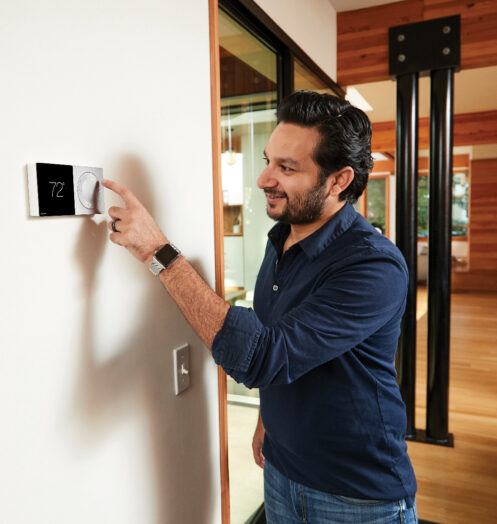
Your HVAC system is an important appliance that keeps you comfortable throughout the year. However, for your HVAC system to operate effectively, you need to properly maintain it and ensure it is ready for a change in seasons. While you are using your air conditioner in the summer, the components that operate your furnace sit unused and can run into issues when you go to turn on the heat for the first time. Here are seven ways you can help your HVAC system transition from summer to fall and be ready for the upcoming demand you will place on your furnace.
1. Change the Air Filter
The air filter inside your HVAC system helps improve air quality by trapping dust, pollen, dirt, and other airborne particles. Since your windows will be closed when running your HVAC in the fall and winter, you want to make sure that your air filter is as clean as possible and help circulate clean air throughout your home. Installing a new air filter as the seasons change to fall will also help improve the efficiency of your HVAC system. A clogged air filter restricts airflow, forcing your HVAC system to work harder than it should. When air can flow freely throughout your system, you use less energy to heat your home once the temperatures dip.
2. Test Your Thermostat
The thermostat works with your HVAC system and regulates the temperature settings throughout your home. When you have an accurate thermostat, you are less likely to deal with frequent cycling and other HVAC performance issues. You will also reduce the wear and tear on your system and extend its lifespan, as your HVAC will shut off as soon as it reaches the target temperature. In addition to making sure your thermostat communicates correctly with your HVAC system, you want to ensure it is accurately reading the temperature in your home. While your thermostat may signal to your HVAC system to turn on, it might not register the change in temperature once it is running, causing your system to run continuously.
3. Check the Heating Elements
Several components work together for your HVAC system to start churning out hot air. It is important that you properly inspect these components before the weather gets cold to ensure they are working correctly before you start using your furnace regularly. Working with an expert HVAC company, such as Woodward Heating Air Plumbing, will enable you to have someone inspect the pilot light or ignition system, burners, and outside of your furnace for any noticeable signs of wear and tear or corrosion that can lead to performance issues. A professional will be able to easily spot minor issues that can be corrected before the demand you’ll place on your HVAC system increases, thus reducing the chances of a full breakdown.
4. Inspect Your Ductwork
Ductwork is a critical but often overlooked component of your HVAC system. It plays a pivotal role in delivering the treated air to all the rooms in your home and ensuring even heating. If there is any issue with your ductwork, your HVAC system can run into performance issues leading to decreased efficiency and poor air quality inside your home. Common issues that can arise with your ductwork are leaks, dents, and blockages. Leaky air ducts will allow cold outside air to enter the system, making it harder for your HVAC to reach the desired temperature. Dents and bends in your ductwork can lead to restricted airflow and cold rooms throughout your house, as do other types of blockages. Mold and mildew growth present a completely different challenge for your HVAC system and the air quality of your home. It is not uncommon for the hot, humid weather of the summer to cause allergens and pollutants to grow inside your air duct system, which can lead to negative health effects.
5.Check for Air Leaks in Your Home
Your air ducts are not the only place in your home where leaks can negatively impact the performance of your HVAC system. To ensure your HVAC system operates at peak performance when transitioning from the summer to the fall, you want to check for any air leaks inside your home. This includes your window seals, door frames, and attics. Any place where warm air can escape your home and be replaced by cold air will make it harder for your HVAC to run efficiently. A knowledgeable HVAC technician can help you determine the best course of action to take to seal these leaks such as using weatherstripping or caulk.
6. Adjust the Vents and Registers
Adjusting the vents and registers in your home is another good way to ready your HVAC system for fall weather. As the weather turns colder, you may want to adjust certain vents to evenly distribute warm air throughout your home. If you have several rooms that you do not use often, you can slightly close the registers in these locations to help redirect the warm air into the rooms that you do use. However, we do not recommend fully closing off the vents. Our team at Woodward Heating Air Plumbing can help assess your home’s airflow and position vents and registers in such a way that will promote the warm air to enter the rooms where you spend the bulk of your time during the fall and winter. Balanced airflow will help you get the most out of your HVAC system and keep your home comfortable without overworking your system in the process. This will help you conserve energy and keep your utility bills as low as possible while remaining comfortable.
7. Check the Humidifier
If your HVAC system has a humidifier, you will want to inspect this component and make sure it is working as intended. Fall is typically accompanied by cooler, drier air, and thus your HVAC system needs to inject moisture into your home’s air to prevent it from being too dry and uncomfortable. Dry air can cause discomfort, skin irritation, and damage to floors and furniture. This process involves inspecting the outside of the humidifier for obvious signs of wear and tear as well as the water supply line. You will also want to make sure that any HVAC maintenance that is done on your system includes removing mineral deposits inside the humidifier that can cause blockages.
Your Reliable HVAC Maintenance Team
Having a dependable HVAC system in Salem, OR is a necessity no matter if it is the peak of summer or the frigid temperatures of the winter. Our certified HVAC technicians know exactly what to do to ensure your HVAC system successfully transitions from summer to fall. We offer a straightforward approach and up-front pricing so there are never any surprises. We also offer dependable plumbing services and new HVAC installation if you are thinking about upgrading to a more energy-efficient model. Contact Woodward Heating Air Plumbing today for furnace maintenance if you want to make sure your HVAC system is ready to handle cold weather before it arrives.






